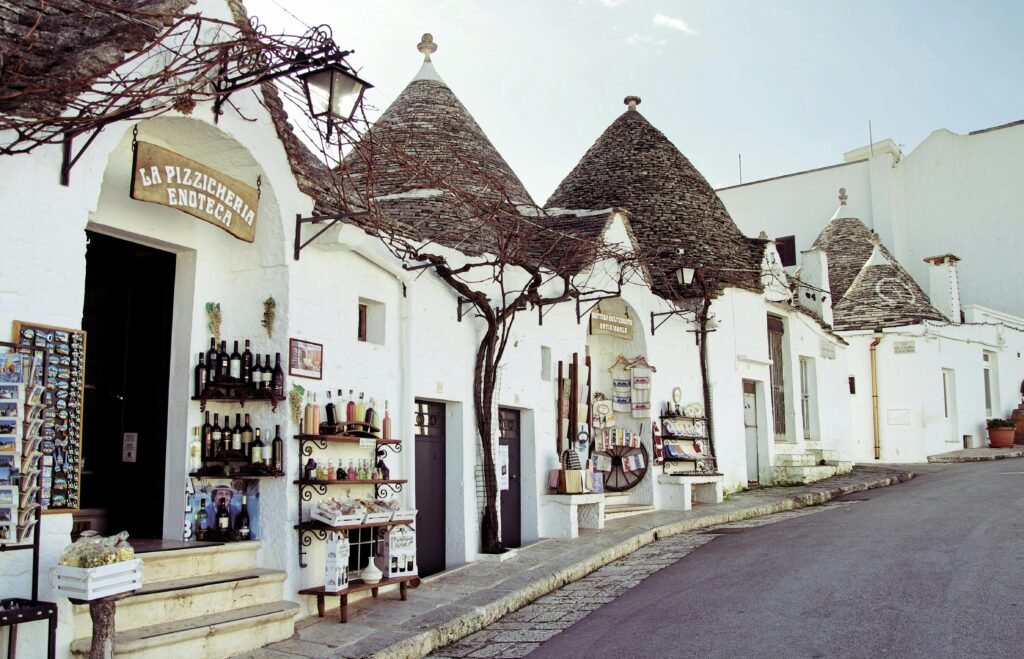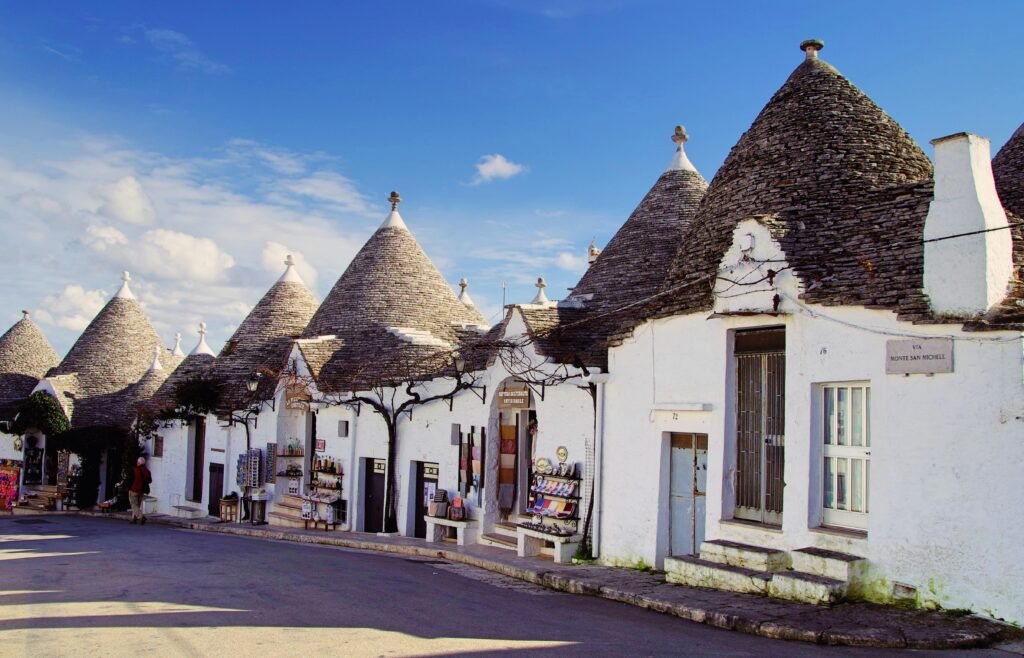Unveiling The Secrets Of Alberobello: The Heart Of Puglia’s Trulli
- Leave a Comment
- Diya S
- January 20, 2025

The charming village of Alberobello, which is located in Puglia, Italy, is well known for its remarkable and distinctive architecture. As evidence of Italy’s rich architectural and cultural legacy, it has been a UNESCO World Heritage site since 1996.
Alberobello’s collection of trulli houses, which are typical dry-stone homes with conical roofs and have come to represent the area, is what really makes it unique. With their quaint whitewashed stone walls, these intriguing buildings are a unique and recognizable aspect of Puglia’s scenery that draws tourists from all over the world.
An essential component of Alberobello’s cultural identity are the town’s 14th-century trulli homes. The trulli were made to be easily disassembled and were built with dry-stone methods without mortar. Because the residences were temporary, the residents were able to avoid paying taxes thanks to this construction style.
These buildings developed into permanent residences throughout time, and they continue to provide an intriguing window into the town’s illustrious past. Alberobello is one of the most unusual places to visit in all of Italy because of its exceptionally well-preserved trulli.
It’s like entering a fantasy world when you visit Alberobello. Everyone who walks through the village is enthralled by the enchanted ambiance created by the rows of trulli along its winding streets. The appeal is increased by the conical roofs, which are frequently embellished with lucky charms.
Alberobello is a thriving town with a lively citizenry in addition to being a marvel of architecture. It is the ideal location for tourists looking for both history and contemporary conveniences because, although many of the trulli are still inhabited, others have been transformed into quaint stores, eateries, and lodgings.
Alberobello, a UNESCO World Heritage site, is extremely important to Italian and global culture. These trulli houses’ preservation offers a window into the life of persons who once occupied these classic buildings and priceless insight into the traditional building techniques of the past.
A trip to Alberobello is a historical adventure, where the distinctive trulli houses serve as timeless reminders of Puglia’s remarkable cultural past.

The Enchantment of Trulli
One of the main characteristics of Alberobello’s distinct appeal is its trulli dwellings. The characteristic conical roofs of these landmark buildings, which are constructed from local limestone without the use of mortar, provide instant recognition. In addition to being aesthetically pleasing, the roofs’ spiral or beehive design serves a functional use.
The interiors are kept warm in the winter and cool in the summer by the thick stone walls, which makes them ideal for surviving Puglia’s Mediterranean environment. These trulli houses’ elegance and simplicity add to the magical ambiance that envelops Alberobello.
During the 14th century, when the area was governed by feudalism, the trulli dwellings first appeared. The historical background of these houses is among its most intriguing features. The trulli are thought to have been built with detachable roofs in order to get around a tax law that the Kingdom of Naples imposed.
Building dwellings with roofs that were readily disassembled allowed the residents to avoid paying the tax, which was dependent on the number of permanent structures in the area. In addition to ensuring that the constructions remained transitory even while they were utilized as long-term residences, this ingenious design gave the trulli a means of resistance to the feudal authority.
As the need for tax evasion decreased throughout the years, Alberobello’s trulli houses changed from being transient residences to permanent residences. These stone huts were transformed into solid, cozy dwellings by the Alberobello residents, who modified and improved the method. The town’s unique identity and legacy have been preserved in large part because to the trulli’s preservation.
While some of these homes have undergone meticulous restoration to preserve their historical integrity, many of them still stand today in their original configuration. Their preservation is essential for maintaining Alberobello’s cultural significance, which qualifies it as a UNESCO World Heritage site, in addition to its architectural value.
The skill and resourcefulness of those who constructed these trulli homes are demonstrated by their continuous existence. Alberobello’s trulli are an integral component of the town’s ongoing culture and are more than just historical relics. The town’s ability to maintain these amazing buildings while adjusting to current circumstances is what makes Alberobello so charming.
The town’s ability to maintain these amazing buildings while adjusting to current circumstances is what makes Alberobello so charming. The town’s architecture still honors the inventiveness of local builders, and the trulli houses give tourists an opportunity to travel back in time and feel the enchantment of a bygone age.

An Exploration of the Trulli District
It’s like entering a dream when you stroll through the Trulli Zone, also known as Rione Monti. More than 1,000 trulli cottages may be found in this part of Alberobello, forming an enthralling scene of whitewashed stone buildings with their recognizable conical roofs.
These quaint homes, some of which are still private residences and others of which have been transformed into stores, eateries, and lodgings, line the twisting, tiny lanes of Rione Monti. You will be enthralled by the district’s harmonious fusion of the town’s rich past and its dynamic modern use, all set against the charming backdrop of the trulli houses.
Rione Monti is one of Italy’s most striking architectural neighborhoods due to the sheer quantity of trulli houses there. It seems as though the entire town is made up of these recognizable buildings as you wind down the winding alleyways; they all have the same unique roof pattern, albeit with subtle variations.
Local crafts, souvenirs, and delectable Puglian delights are sold by small businesses along the streets, creating a vibrant atmosphere that encourages visitors and locals alike to stay and explore. The trulli are an integral part of Alberobello’s live, breathing heart, not merely a relic from the past.
The largest trullo in Alberobello, the Trullo Sovrano, is one of the most prominent features of Rione Monti. This two-story trullo is a testament to the town’s inventive architectural style. The Trullo Sovrano has an additional level and provides an intriguing glimpse into the conventional living quarters of the past, in contrast to the single-story trulli dotted across the region.
Visitors can take a tour of the interior to learn more about the history of this amazing building and observe how the trulli were modified to accommodate larger families. As a monument to the development of trulli homes, the Trullo Sovrano continues to enthrall visitors today while providing a window into the past.
Many of the trulli in Rione Monti have been carefully converted into shops and lodgings, adding to the area’s historical charm. These days, some are boutique hotels or comfortable guesthouses that let guests spend the night in a classic trullo, providing a distinctive and genuine experience.
Others have been converted into stores where guests may buy artisan products, handicrafts, and even traditional olive oils made in the area. By bridging the gap between history and modern life, this renovation of the trulli houses guarantees that the district stays vibrant and functioning, making Rione Monti a must-see location in Alberobello.

To really experience Alberobello’s beauty, a trip to the Trulli Zone, also known as Rione Monti, is ideal. More than 1,000 trulli houses can be found in this neighborhood, forming an enthralling maze of winding lanes dotted with these famous buildings.
You are transported to a another era by the almost magical ambiance created by the conical roofs of the trulli and the bleached stone walls as you meander through the twisting paths.
One of Alberobello’s best-preserved neighborhoods is the Rione Monti sector, where you can find stunning trullos with distinctive histories and designs around every corner. The Trulli Zone is a must-see for anyone traveling to Alberobello, whether they are taking a leisurely stroll or trying to get the ideal shot.
The largest trullo in Alberobello, the Trullo Sovrano, is one of the several attractions in the Rione Monti neighborhood. A marvel of construction, this two-story trullo provides a view of the roomy interiors of these classic homes. With its conical roof and stone walls that rise well above the other trulli in the area, the Trullo Sovrano is a testament to the town’s architectural inventiveness.
To discover more about the Trullo Sovrano’s history and how it was used as a dwelling, visitors can take a tour. A major attraction of any visit through Alberobello’s Trulli Zone, its enormous size distinguishes it from the other trulli.
Since many of the trulli houses in Rione Monti have been converted, the neighborhood has become a bustling hub where the past and present coexist. Several of these quaint houses have been converted into stores that sell handcrafted trinkets, regional handicrafts, and distinctive goods influenced by the town’s rich history.
Others have been transformed into lodgings, enabling tourists to stay in the very kind of home that has made Alberobello well-known. The Trulli Zone has a distinct atmosphere where the past and present dwell harmoniously because of this fusion of history and contemporary. It is a fantastic experience to browse in one of its many shops or stay in a trullo.
The winding alleyways of the Trulli Zone are a live reminder of Alberobello’s enduring culture, not just a location to explore. With more than 1,000 trulli homes, the Rione Monti neighborhood provides a deep and genuine experience that immerses guests in Puglia’s architectural past.
Any vacation to Alberobello must include a stroll down Rione Monti, whether you’re admiring the Trullo Sovrano, shopping in a converted trullo, or just taking in the splendor of this unique neighborhood. The beauty and cultural significance that make Alberobello such a unique place are aptly captured by the Trulli Zone.
It is strongly advised to visit the Trullo Museum in order to completely comprehend the significance of the trulli dwellings and their history. This tiny but educational museum provides a thorough examination of the trulli’s development over the ages and the ancient building methods that were employed to construct them.
The museum’s displays give important background information on how these homes were made without cement and utilizing dry stone methods. From the early days of trullo construction to their significance in Alberobello’s social and economic life, it also illustrates the region’s rich history. You can better appreciate these architectural marvels and the creativity that went into creating them by going to the Trullo Museum.
For visitors interested in Alberobello’s rich cultural legacy, the Church of Saint Anthony is a must-see in addition to the Trullo Museum. The Church of Saint Anthony, a masterwork of architecture constructed entirely in the trullo style, is situated in the Trulli Zone.
The church is a remarkable example of the blending of local architecture and religion because its conical roof reflects the shape of the nearby trulli dwellings. Inside, guests can appreciate the tasteful yet understated interior design, which echoes the harmony of the town’s trulli houses. In addition to being a house of worship, the Church of Saint Anthony represents the close ties that exist between the people of Alberobello and their architectural heritage.
For the residents of Alberobello, the Church of Saint Anthony is a place of great religious significance. It was built in the early 20th century to accommodate the town’s Trulli Zone’s expanding population. The church developed into a hub for religious and cultural events as the neighborhood grew.
It is now a house of worship that draws both residents and tourists who come to take in its distinctive architecture and calm ambiance. The church is a must-see for anybody wishing to comprehend Alberobello’s architectural and spiritual culture because of its link to the trulli dwellings, which gives its beauty an additional layer of significance.
The Church of Saint Anthony and the Trullo Museum both offer a more thorough picture of the town’s past and culture. These locations provide information about the lives of the people who constructed the trulli houses and how architecture was an integral part of their everyday routines.
Whether you’re interested in the town’s religious customs or the trulli’s construction methods, Alberobello’s cultural landmarks are essential to fully appreciating this remarkable village.
Puglia’s allure goes well beyond the alluring village of Alberobello; neighboring towns like Locorotondo and Martina Franca have their own special attractions. Known for its round design, Locorotondo offers sweeping vistas of the Valle d’Itria and its winding alleys adorned with whitewashed homes.
With its distinctive trulli buildings and quaint piazzas, the town’s ancient core is ideal for leisurely exploration. In contrast, Martina Franca is renowned for its exquisite churches and baroque architecture. The world-renowned Festival della Valle d’Itria, a classical music festival that draws artists and tourists from all over the world, is also held in the town.
One of Puglia’s most alluring aspects is its natural beauty, which includes a scenery that blends large olive fields, green hills, and elegant coastline living. Visitors can find a tranquil haven by the sea along the area’s coastline, which is lined with charming beaches, cliffs, and secret coves.
The beaches of Puglia are a paradise for those who love the outdoors and the sun, whether they are the sandy coastlines of Torre Guaceto Nature Reserve or the pristine waters of Polignano a Mare.
With their historic vineyards and olive orchards, the undulating hills of the Valle d’Itria provide a tranquil rural setting that seems unspoiled by time. Discovering Puglia’s natural splendor offers the chance to become fully immersed in the peace and quiet of the area and establish a connection with its long-standing agricultural customs.

Another important component of Puglia’s allure is its cuisine, which has flavors derived from the region’s agricultural past. The quality of the local olive oil is well known, and tourists can visit olive fields to observe the age-old production techniques.
Another feature of Puglia is its seafood, which includes meals like orecchiette with fish that emphasize the region’s fresh, local ingredients and include fresh catches from the Adriatic and Ionian Seas.
Orecchiette pasta, a tiny, ear-shaped pasta that is usually served with a variety of sauces—most notably, turnip greens—is another Puglian culinary specialty. Puglia’s cuisine is a must-try for any foodie traveling to the area because of its simplicity and richness, which provide a genuine sense of the Mediterranean.
Puglia’s cuisine, scenery, and culture all come together to make for a memorable trip. The region’s diverse culinary culture reflects its beauty, whether you’re strolling through the olive orchards or indulging in local specialties in a little hamlet like Martina Franca.
The area is renowned for its genuine flavors and traditional cuisine, and the natural surroundings—from the rocky coasts to the serene hills—make the ideal setting. Its capacity to enthrall the senses and provide a profound connection to culture and nature that lingers with tourists long after they depart is what makes Puglia so alluring.
Spring and October are the ideal seasons to visit Alberobello because of the lovely weather and reduced people. The town is alive with blooming flowers in the spring, and the pleasant weather makes it a pleasure to stroll around the Trulli Zone’s winding streets.
However, with the summer visitors gone and the harvest season adding a new dimension of attractiveness to the area, fall offers lower temperatures and a more tranquil ambiance. You may truly appreciate the splendor of the trulli houses, the surrounding landscape, and the slower pace of life in Alberobello by traveling during these seasons.
With excellent transportation choices from neighboring cities like Bari and Brindisi, getting to Alberobello is simple. Regular trains from Bari Centrale provide good train connections to the town; it takes around an hour and a half to get to Alberobello’s train station. Although it takes a little longer from Brindisi, the rail trip is just as accessible.
Renting a car is a fantastic choice for individuals who would rather drive, giving you the freedom to see Alberobello at your own speed. Beautiful vistas of the area’s rolling hills and olive trees can be seen during the picturesque trip through the Valle d’Itria. Alberobello is a convenient location for anyone going through Puglia because it is easy to get to by car or train.
Alberobello’s trulli-inspired hotels and guesthouses provide a distinctive lodging experience. Visitors who wish to experience the town’s charm to the fullest must stay in a trullo. A lot of these trulli have been transformed into bed and breakfasts or boutique hotels, offering a genuine and comfortable stay. While some of the trulli are ideal for a romantic retreat, others are larger and can house families or parties.
A number of high-end establishments provide contemporary conveniences while maintaining the classic trullo architecture for a more opulent stay, guaranteeing an exceptional trip to Alberobello. Alberobello’s lodging options let you take in the town’s distinct character, whether you decide to stay in a standard hotel or a beautiful trullo.
Enjoying the local cuisine is a must-do while visiting Alberobello. Orecchiette pasta, usually served with turnip greens in a simple but tasty sauce, is a must-try dish in Puglia. The recipe provides a genuine flavor of Puglia’s rich culinary traditions and emphasizes the region’s emphasis on using local, fresh ingredients.
Enjoy a glass of Primitivo wine, a strong red wine that is a regional specialty, with your dinner. Primitivo is renowned for its complex tastes, which go well with the depth of Puglian food. The local cuisine will undoubtedly be the highlight of your trip, whether you’re eating in a classic trattoria or one of Alberobello’s trulli-turned-restaurants.
Conclusion:
Alberobello is a town that offers a distinctive fusion of culture, architecture, and history. With its conical roofs and quaint whitewashed stone walls, the recognizable trulli cottages evoke a fanciful environment that takes guests back in time.
Alberobello provides a memorable experience for anybody interested in discovering Italy’s rich architectural legacy, whether they choose to explore the winding lanes of Rione Monti or take in the largest trullo at Trullo Sovrano. The town is a must-see location in Puglia because of its unique character and bustling yet serene ambiance.
Alberobello provides a window into the agricultural and gastronomic traditions of Puglia in addition to its stunning architecture. The town welcomes guests to enjoy the basic joys of southern Italian living, from the picturesque views of vineyards and olive groves to the mouthwatering regional cuisine.
Indulging in a bottle of Primitivo wine or sampling orecchiette pasta with turnip greens at one of Alberobello’s welcoming restaurants is a delightful way to experience the local cuisine. Alberobello is a place worth enjoying because of its rich history and genuine local experiences.
Exploring the neighboring villages of Locorotondo and Martina Franca, each with its own distinct beauty, is another benefit of visiting Alberobello. These cities enhance Alberobello’s allure by enabling tourists to take in the Valle d’Itria’s wider cultural and natural splendor, from the whitewashed houses of Locorotondo to the baroque beauty of Martina Franca.
The trip is further enhanced by the natural beauty of Puglia’s rolling hills, olive groves, and coastlines, which offer a peaceful retreat into a setting that has inspired centuries.
Alberobello embodies Puglia, where culture, history, and scenic beauty all converge in a way that is genuinely enchanted. Travelers can have a memorable time in Alberobello whether they choose to explore its well-known trulli houses, indulge in regional cuisine, or just take in the town’s timeless charm.
It’s a place that encourages you to take it slow, enjoy the beauty all around you, and make lifelong memories in one of the most charming villages in Italy.
